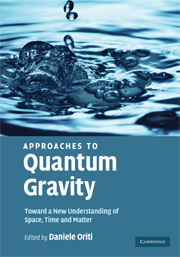Book contents
- Frontmatter
- Contents
- List of contributors
- Preface
- Part I Fundamental ideas and general formalisms
- Part II String/M-theory
- Part III Loop quantum gravity and spin foam models
- Part IV Discrete Quantum Gravity
- 18 Quantum Gravity: the art of building spacetime
- 19 Quantum Regge calculus
- 20 Consistent discretizations as a road to Quantum Gravity
- 21 The causal set approach to Quantum Gravity
- Questions and answers
- Part V Effective models and Quantum Gravity phenomenology
- Index
21 - The causal set approach to Quantum Gravity
from Part IV - Discrete Quantum Gravity
Published online by Cambridge University Press: 26 October 2009
- Frontmatter
- Contents
- List of contributors
- Preface
- Part I Fundamental ideas and general formalisms
- Part II String/M-theory
- Part III Loop quantum gravity and spin foam models
- Part IV Discrete Quantum Gravity
- 18 Quantum Gravity: the art of building spacetime
- 19 Quantum Regge calculus
- 20 Consistent discretizations as a road to Quantum Gravity
- 21 The causal set approach to Quantum Gravity
- Questions and answers
- Part V Effective models and Quantum Gravity phenomenology
- Index
Summary
How can we reach a theory of Quantum Gravity? Many answers to this question are proposed in the different chapters of this book. A more specific set of questions might be: what demands should we put on our framework, so that it is best able to meet all the challenges involved in creating a theory of Quantum Gravity? What choices are most likely to give the correct theory, according to the clues we have from known physics? Are there any problems with our initial assumptions that may lead to trouble further down the road? The latter seems to be one of the most important strategic questions when beginning to formulate a candidate theory. For example, can a canonical approach overcome the multifaceted problem of time? And how far can a theory based on a fixed background spacetime be pushed? On the one hand, these questions may only be answered in the very attempt to formulate the theory. On the other, many such attempts have been made, and now that Quantum Gravity research has built up some history, perhaps it is time to plough some of the experience gained back into a new approach, laying the groundwork for our theory in such a way as to avoid well-known problems. The causal set program represents such an attempt.
In this review, some answers to the above questions, as embodied by the causal set program, are set out and explained, and some of their consequences are given.
- Type
- Chapter
- Information
- Approaches to Quantum GravityToward a New Understanding of Space, Time and Matter, pp. 393 - 413Publisher: Cambridge University PressPrint publication year: 2009
- 32
- Cited by

